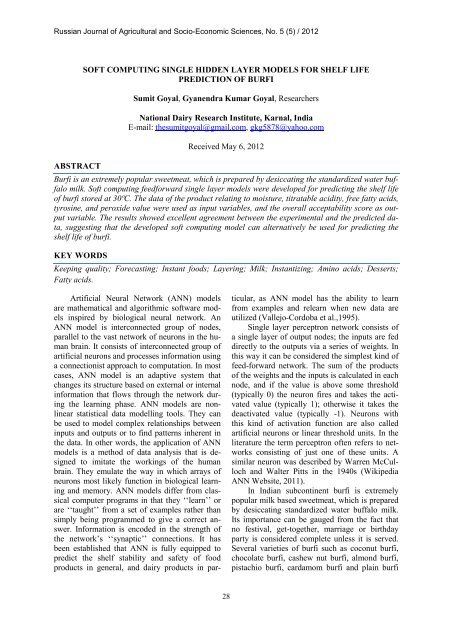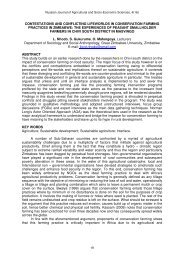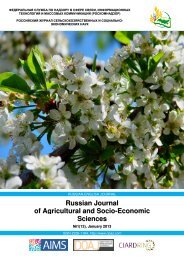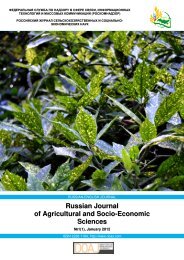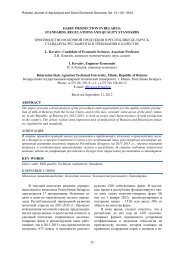Full text in PDF - Russian Journal of Agricultural and Socio ...
Full text in PDF - Russian Journal of Agricultural and Socio ...
Full text in PDF - Russian Journal of Agricultural and Socio ...
Create successful ePaper yourself
Turn your PDF publications into a flip-book with our unique Google optimized e-Paper software.
<strong>Russian</strong> <strong>Journal</strong> <strong>of</strong> <strong>Agricultural</strong> <strong>and</strong> <strong>Socio</strong>-Economic Sciences, No. 5 (5) / 2012<br />
ABSTRACT<br />
SOFT COMPUTING SINGLE HIDDEN LAYER MODELS FOR SHELF LIFE<br />
PREDICTION OF BURFI<br />
Sumit Goyal, Gyanendra Kumar Goyal, Researchers<br />
National Dairy Research Institute, Karnal, India<br />
E-mail: thesumitgoyal@gmail.com, gkg5878@yahoo.com<br />
Received May 6, 2012<br />
Burfi is an extremely popular sweetmeat, which is prepared by desiccat<strong>in</strong>g the st<strong>and</strong>ardized water buffalo<br />
milk. S<strong>of</strong>t comput<strong>in</strong>g feedforward s<strong>in</strong>gle layer models were developed for predict<strong>in</strong>g the shelf life<br />
<strong>of</strong> burfi stored at 30ºC. The data <strong>of</strong> the product relat<strong>in</strong>g to moisture, titratable acidity, free fatty acids,<br />
tyros<strong>in</strong>e, <strong>and</strong> peroxide value were used as <strong>in</strong>put variables, <strong>and</strong> the overall acceptability score as output<br />
variable. The results showed excellent agreement between the experimental <strong>and</strong> the predicted data,<br />
suggest<strong>in</strong>g that the developed s<strong>of</strong>t comput<strong>in</strong>g model can alternatively be used for predict<strong>in</strong>g the<br />
shelf life <strong>of</strong> burfi.<br />
KEY WORDS<br />
Keep<strong>in</strong>g quality; Forecast<strong>in</strong>g; Instant foods; Layer<strong>in</strong>g; Milk; Instantiz<strong>in</strong>g; Am<strong>in</strong>o acids; Desserts;<br />
Fatty acids.<br />
Artificial Neural Network (ANN) models<br />
are mathematical <strong>and</strong> algorithmic s<strong>of</strong>tware models<br />
<strong>in</strong>spired by biological neural network. An<br />
ANN model is <strong>in</strong>terconnected group <strong>of</strong> nodes,<br />
parallel to the vast network <strong>of</strong> neurons <strong>in</strong> the human<br />
bra<strong>in</strong>. It consists <strong>of</strong> <strong>in</strong>terconnected group <strong>of</strong><br />
artificial neurons <strong>and</strong> processes <strong>in</strong>formation us<strong>in</strong>g<br />
a connectionist approach to computation. In most<br />
cases, ANN model is an adaptive system that<br />
changes its structure based on external or <strong>in</strong>ternal<br />
<strong>in</strong>formation that flows through the network dur<strong>in</strong>g<br />
the learn<strong>in</strong>g phase. ANN models are nonl<strong>in</strong>ear<br />
statistical data modell<strong>in</strong>g tools. They can<br />
be used to model complex relationships between<br />
<strong>in</strong>puts <strong>and</strong> outputs or to f<strong>in</strong>d patterns <strong>in</strong>herent <strong>in</strong><br />
the data. In other words, the application <strong>of</strong> ANN<br />
models is a method <strong>of</strong> data analysis that is designed<br />
to imitate the work<strong>in</strong>gs <strong>of</strong> the human<br />
bra<strong>in</strong>. They emulate the way <strong>in</strong> which arrays <strong>of</strong><br />
neurons most likely function <strong>in</strong> biological learn<strong>in</strong>g<br />
<strong>and</strong> memory. ANN models differ from classical<br />
computer programs <strong>in</strong> that they ‘‘learn’’ or<br />
are ‘‘taught’’ from a set <strong>of</strong> examples rather than<br />
simply be<strong>in</strong>g programmed to give a correct answer.<br />
Information is encoded <strong>in</strong> the strength <strong>of</strong><br />
the network’s ‘‘synaptic’’ connections. It has<br />
been established that ANN is fully equipped to<br />
predict the shelf stability <strong>and</strong> safety <strong>of</strong> food<br />
products <strong>in</strong> general, <strong>and</strong> dairy products <strong>in</strong> particular,<br />
as ANN model has the ability to learn<br />
from examples <strong>and</strong> relearn when new data are<br />
utilized (Vallejo-Cordoba et al.,1995).<br />
S<strong>in</strong>gle layer perceptron network consists <strong>of</strong><br />
a s<strong>in</strong>gle layer <strong>of</strong> output nodes; the <strong>in</strong>puts are fed<br />
directly to the outputs via a series <strong>of</strong> weights. In<br />
this way it can be considered the simplest k<strong>in</strong>d <strong>of</strong><br />
feed-forward network. The sum <strong>of</strong> the products<br />
<strong>of</strong> the weights <strong>and</strong> the <strong>in</strong>puts is calculated <strong>in</strong> each<br />
node, <strong>and</strong> if the value is above some threshold<br />
(typically 0) the neuron fires <strong>and</strong> takes the activated<br />
value (typically 1); otherwise it takes the<br />
deactivated value (typically -1). Neurons with<br />
this k<strong>in</strong>d <strong>of</strong> activation function are also called<br />
artificial neurons or l<strong>in</strong>ear threshold units. In the<br />
literature the term perceptron <strong>of</strong>ten refers to networks<br />
consist<strong>in</strong>g <strong>of</strong> just one <strong>of</strong> these units. A<br />
similar neuron was described by Warren McCulloch<br />
<strong>and</strong> Walter Pitts <strong>in</strong> the 1940s (Wikipedia<br />
ANN Website, 2011).<br />
In Indian subcont<strong>in</strong>ent burfi is extremely<br />
popular milk based sweetmeat, which is prepared<br />
by desiccat<strong>in</strong>g st<strong>and</strong>ardized water buffalo milk.<br />
Its importance can be gauged from the fact that<br />
no festival, get-together, marriage or birthday<br />
party is considered complete unless it is served.<br />
Several varieties <strong>of</strong> burfi such as coconut burfi,<br />
chocolate burfi, cashew nut burfi, almond burfi,<br />
pistachio burfi, cardamom burfi <strong>and</strong> pla<strong>in</strong> burfi<br />
28
S. GOYAL, G.K. GOYAL, National Dairy Research Institute<br />
are sold <strong>in</strong> the market, but the latter variety is<br />
most popular which conta<strong>in</strong>s milk solids <strong>and</strong><br />
sugar. The upper surface <strong>of</strong> the burfi pieces are<br />
essentially coated with an edible th<strong>in</strong> metallic<br />
silver leaf for the ma<strong>in</strong> reason <strong>of</strong> mak<strong>in</strong>g the<br />
product more attractive, besides therapeutic value<br />
<strong>of</strong> silver.<br />
Shelf life studies provide useful <strong>in</strong>formation<br />
to the product developers <strong>and</strong> manufacturers<br />
enabl<strong>in</strong>g them to ensure that the consumer will<br />
get a high quality product for a significant period<br />
<strong>of</strong> time after its production. S<strong>in</strong>ce the shelf life<br />
evaluation <strong>of</strong> the food products conducted <strong>in</strong> the<br />
laboratory is very expensive, cumbersome, long<br />
time tak<strong>in</strong>g process, <strong>and</strong> also do not fit with the<br />
speed requirement <strong>of</strong> the food manufactur<strong>in</strong>g<br />
compnies, hence accelerated studies have been<br />
<strong>in</strong>novated. The modern food <strong>in</strong>dustry has developed<br />
<strong>and</strong> exp<strong>and</strong>ed because <strong>of</strong> its ability to deliver<br />
a wide variety <strong>of</strong> high quality food products to<br />
consumers worldwide. This has been possible by<br />
build<strong>in</strong>g stability <strong>in</strong>to the products through<br />
process<strong>in</strong>g, packag<strong>in</strong>g, <strong>and</strong> additives that enable<br />
foods to rema<strong>in</strong> fresh <strong>and</strong> wholesome throughout<br />
the distribution process. Consumer dem<strong>and</strong>s for<br />
high-quality foods with “fresh-like” characteristics<br />
<strong>and</strong> for convenience such as RTC (ready-tocook)<br />
<strong>and</strong> RTE (ready-to-eat). This has fueled<br />
new <strong>in</strong>novations <strong>in</strong> the food product development,<br />
packag<strong>in</strong>g <strong>and</strong> chemical <strong>in</strong>dustries, <strong>and</strong> the<br />
widespread desire for products to use <strong>in</strong> the microwave<br />
oven has added further impetus to this<br />
effort. As an <strong>in</strong>creas<strong>in</strong>g number <strong>of</strong> new foods<br />
compete for space on supermarket shelves, the<br />
words “speed <strong>and</strong> <strong>in</strong>novation” have become the<br />
watchwords for food companies seek<strong>in</strong>g to become<br />
“first to market” with successful products.<br />
The overal quality <strong>of</strong> the product is extremely<br />
important <strong>in</strong> this competitive market <strong>and</strong> <strong>in</strong>novation<br />
system. How the consumer feels about the<br />
product is the ultimate measure <strong>of</strong> food quality.<br />
Therefore, the quality built <strong>in</strong> dur<strong>in</strong>g the development<br />
<strong>and</strong> production process must last through<br />
the distribution <strong>and</strong> consumption stages (Medlabs<br />
Website, 2011).<br />
ANNs have been applied for predict<strong>in</strong>g the<br />
shelf life <strong>of</strong> the several milk based products:<br />
cakes (Goyal <strong>and</strong> Goyal, 2011a, 2011b), Kalak<strong>and</strong><br />
(Goyal <strong>and</strong> Goyal, 2011c), c<strong>of</strong>fee dr<strong>in</strong>k<br />
(Goyal <strong>and</strong> Goyal, 2011d, 2011e, 2011f), milky<br />
white dessert jeweled with pistachio (Goyal <strong>and</strong><br />
Goyal, 2011g), brown milk cake decorated with<br />
almonds (Goyal <strong>and</strong> Goyal, 2011h), <strong>and</strong> s<strong>of</strong>t<br />
mouth melt<strong>in</strong>g milk cakes (Goyal <strong>and</strong> Goyal,<br />
2011i). Doganis et al. (2006) developed a methodology<br />
based on ANN models <strong>and</strong> evolutionary<br />
comput<strong>in</strong>g for time series sales forecast<strong>in</strong>g for<br />
short shelf life food products, <strong>and</strong> claimed that<br />
the methodology is particularly useful for manufacturers<br />
<strong>of</strong> fresh milk, s<strong>in</strong>ce successful sales forecast<strong>in</strong>g<br />
reduces considerably the lost sales <strong>and</strong><br />
products returns. This study aims to develop s<strong>of</strong>t<br />
comput<strong>in</strong>g feedforward s<strong>in</strong>gle layer models for<br />
predict<strong>in</strong>g the shelf life <strong>of</strong> burfi stored at 30ºC.<br />
METHOD MATERIAL<br />
For develop<strong>in</strong>g the s<strong>of</strong>t comput<strong>in</strong>g feedforward<br />
s<strong>in</strong>gle layer model, the experimental data <strong>of</strong><br />
burfi related to moisture, titratable acidity (TA),<br />
free fatty acids (FFA), tyros<strong>in</strong>e, <strong>and</strong> peroxide<br />
value (PV) were taken as <strong>in</strong>put variables, <strong>and</strong> the<br />
overall acceptability score (OAS) as output variable<br />
(Fig.1).<br />
Moisture<br />
TA<br />
FFA<br />
Tyros<strong>in</strong>e<br />
PV<br />
Figure 1 – Input <strong>and</strong> output variables<br />
<strong>of</strong> ANN model<br />
Mean square error (MSE) (1), root mean<br />
square error (RMSE) (2), coefficient <strong>of</strong> determ<strong>in</strong>ation<br />
(R2) (3) <strong>and</strong> nash - sutcliffo coefficient<br />
(E2) (4) were used <strong>in</strong> order to compare the shelf<br />
life prediction capability <strong>of</strong> the developed models.<br />
⎡ N ⎛ Q<br />
MSE = ⎢∑⎜<br />
⎢<br />
1<br />
⎣ ⎝<br />
exp<br />
− Q<br />
n<br />
cal<br />
2<br />
⎞ ⎤<br />
⎟ ⎥<br />
⎠ ⎥<br />
⎦<br />
(1)<br />
OAS<br />
29
3 4 5 6 7 8<br />
<strong>Russian</strong> <strong>Journal</strong> <strong>of</strong> <strong>Agricultural</strong> <strong>and</strong> <strong>Socio</strong>-Economic Sciences, No. 5 (5) / 2012<br />
⎡ ⎛Qexp<br />
−Q<br />
RMSE= ⎢∑⎜<br />
n ⎢<br />
1<br />
⎣ ⎝ Qexp<br />
R<br />
E<br />
2<br />
2<br />
1 N cal<br />
⎡ N ⎛ Q<br />
⎢ ⎜<br />
exp<br />
− Q<br />
= 1−<br />
⎢∑⎜<br />
2<br />
1<br />
⎣ ⎝ Qexp<br />
⎡ N ⎛ Q<br />
= 1−<br />
⎢∑⎜<br />
⎢ ⎜<br />
⎣ ⎝ Q<br />
exp<br />
− Q<br />
− Q<br />
cal<br />
cal<br />
1 exp exp<br />
⎞ 2 ⎤<br />
⎟ ⎥<br />
⎠ ⎥<br />
⎦ (2)<br />
2<br />
⎞ ⎤<br />
⎟ ⎥<br />
⎟ ⎥<br />
⎠ ⎦<br />
2<br />
⎞ ⎤<br />
⎟ ⎥<br />
⎟ ⎥<br />
⎠ ⎦<br />
(3)<br />
(4)<br />
Where:<br />
Q = Observed value;<br />
exp<br />
Q = Predicted value;<br />
Q<br />
cal<br />
exp<br />
=Mean predicted value;<br />
n = Number <strong>of</strong> observations <strong>in</strong> dataset.<br />
RESULTS AND DISCUSSION<br />
The results <strong>of</strong> the Feedforward s<strong>in</strong>gle layer<br />
s<strong>of</strong>t comput<strong>in</strong>g models are displayed <strong>in</strong> table 1.<br />
Neurons<br />
MSE<br />
3 2.96363E-05<br />
4 1.64008E-05<br />
5 5.17191E-07<br />
6 5.22986E-07<br />
7 3.09666E-06<br />
8 1.88275E-07<br />
9 2.02479E-07<br />
10 4.39831E-06<br />
11 7.42676E-05<br />
12 4.28114E-06<br />
13 2.56263E-07<br />
14 2.86094E-06<br />
15 1.83081E-05<br />
16 7.32325E-07<br />
17 6.52134E-07<br />
18 1.53131E-05<br />
19 3.92317E-05<br />
20 3.53538E-06<br />
Table 1 – Results <strong>of</strong> feedforward s<strong>in</strong>gle layer model<br />
RMSE<br />
R2<br />
0.005443919 0.994556081<br />
0.004049793 0.995950207<br />
0.00071916 0.99928084<br />
0.000723177 0.999276823<br />
0.001759732 0.998240268<br />
0.000433906 0.999566094<br />
0.000449977 0.999550023<br />
0.002097214 0.997902786<br />
0.008617864 0.991382136<br />
0.002069091 0.997930909<br />
0.000506224 0.999493776<br />
0.001691432 0.998308568<br />
0.0042788 0.9957212<br />
0.00085576 0.99914424<br />
0.000807548 0.999192452<br />
0.003913193 0.996086807<br />
0.00626352 0.99373648<br />
0.001880261 0.998119739<br />
E2<br />
0.999970364<br />
0.999983599<br />
0.999999483<br />
0.999999477<br />
0.999996903<br />
0.999999812<br />
0.999999798<br />
0.999995602<br />
0.999925732<br />
0.999995719<br />
0.999999744<br />
0.999997139<br />
0.999981692<br />
0.999999268<br />
0.999999348<br />
0.999984687<br />
0.999960768<br />
0.999996465<br />
The comparison <strong>of</strong> Actual Overall Acceptability<br />
Score (AOAS) <strong>and</strong> Predicted Overall Ac-<br />
ceptability Score (POAS) for the feedforward<br />
s<strong>in</strong>gle layer model is illustrated <strong>in</strong> Fig. 2.<br />
9<br />
OAS<br />
8<br />
7<br />
6<br />
POAS<br />
AOAS<br />
1 2<br />
POAS<br />
Validation Data<br />
Figure 2 – Comparison <strong>of</strong> ASS <strong>and</strong> PSS for L<strong>in</strong>ear Layer model<br />
30
S. GOYAL, G.K. GOYAL, National Dairy Research Institute<br />
Feedforward s<strong>in</strong>gle layer s<strong>of</strong>t comput<strong>in</strong>g<br />
model was developed for predict<strong>in</strong>g the shelf life<br />
<strong>of</strong> burfi stored at 30 o C.Several experiments were<br />
performed <strong>in</strong> order to reach an optimum result. A<br />
perusal <strong>of</strong> Table 1 <strong>in</strong>dicates that the comb<strong>in</strong>ation<br />
<strong>of</strong> 591 resulted <strong>in</strong> best correlation between<br />
the experimental <strong>and</strong> the predicted values with<br />
high R 2 (0.999550023), E 2 (0.999550023) <strong>and</strong><br />
low RMSE (0.000449977), establish<strong>in</strong>g that the<br />
feedforward s<strong>in</strong>gle layer s<strong>of</strong>t comput<strong>in</strong>g models<br />
got simulated extremely well, <strong>and</strong> can be used to<br />
predict the shelf life <strong>of</strong> burfi.<br />
CONCLUSION<br />
In the development <strong>of</strong> the prediction model<br />
for determ<strong>in</strong><strong>in</strong>g the shelf life <strong>of</strong> burfi stored at<br />
30 o C, the experimental data <strong>of</strong> the product relat<strong>in</strong>g<br />
to moisture, titratable acidity, free fatty acids,<br />
tyros<strong>in</strong>e, <strong>and</strong> peroxide value were used as <strong>in</strong>put<br />
variables, <strong>and</strong> the overall acceptability score as<br />
output variable. Mean square error, root mean<br />
square error, coefficient <strong>of</strong> determ<strong>in</strong>ation <strong>and</strong><br />
nash - sutcliffo coefficient were impelemented as<br />
performance measures for test<strong>in</strong>g the feedforward<br />
s<strong>in</strong>gle layer model’s prediction ability. Excellent<br />
agreement was found between the tra<strong>in</strong><strong>in</strong>g <strong>and</strong><br />
the validation data. Comb<strong>in</strong>ation <strong>of</strong> 591<br />
gave the best results show<strong>in</strong>g that the developed<br />
models can successfully analyze the non – l<strong>in</strong>ear<br />
multivariate data. From the study, it is concluded<br />
that the s<strong>of</strong>t comput<strong>in</strong>g feedforward s<strong>in</strong>gle layer<br />
models are very effective <strong>in</strong> predict<strong>in</strong>g the shelf<br />
life <strong>of</strong> burfi.<br />
REFERENCES<br />
Doganis, P., Alex<strong>and</strong>ridis, A., Patr<strong>in</strong>os, P. <strong>and</strong><br />
Sarimveis, H. (2006). Time series sales<br />
forecast<strong>in</strong>g for short shelf-life food products<br />
based on artificial neural network<br />
models <strong>and</strong> evolutionary comput<strong>in</strong>g.<br />
<strong>Journal</strong> <strong>of</strong> Food Eng<strong>in</strong>eer<strong>in</strong>g, 75,196-204.<br />
Goyal, Sumit, <strong>and</strong> Goyal, G.K. (2011a). Bra<strong>in</strong><br />
based artificial neural network scientific<br />
comput<strong>in</strong>g models for shelf life prediction<br />
<strong>of</strong> cakes. Canadian <strong>Journal</strong> on Artificial<br />
Intelligence, Mach<strong>in</strong>e Learn<strong>in</strong>g <strong>and</strong> Pattern<br />
Recognition, 2(6), 73-77.<br />
Goyal, Sumit, <strong>and</strong> Goyal, G. K. (2011b). Simulated<br />
neural network <strong>in</strong>telligent comput<strong>in</strong>g<br />
models for predict<strong>in</strong>g shelf life <strong>of</strong><br />
s<strong>of</strong>t cakes. Global <strong>Journal</strong> <strong>of</strong> Computer<br />
Science <strong>and</strong> Technology, 11(14), Version<br />
1.0, 29-33.<br />
Goyal, Sumit, <strong>and</strong> Goyal, G.K. (2011c). Advanced<br />
comput<strong>in</strong>g research on cascade<br />
s<strong>in</strong>gle <strong>and</strong> double hidden layers for detect<strong>in</strong>g<br />
shelf life <strong>of</strong> kalak<strong>and</strong>: An artificial<br />
neural network approach. International<br />
<strong>Journal</strong> <strong>of</strong> Computer Science & Emerg<strong>in</strong>g<br />
Technologies, 2(5), 292-295.<br />
Goyal, Sumit, <strong>and</strong> Goyal, G.K. (2011d). Application<br />
<strong>of</strong> artificial neural eng<strong>in</strong>eer<strong>in</strong>g<br />
<strong>and</strong> regression models for forecast<strong>in</strong>g<br />
shelf life <strong>of</strong> <strong>in</strong>stant c<strong>of</strong>fee dr<strong>in</strong>k. International<br />
<strong>Journal</strong> <strong>of</strong> Computer Science Issues,<br />
8(4), No 1, 320-324.<br />
Goyal, Sumit, <strong>and</strong> Goyal, G.K. (2011e). Cascade<br />
<strong>and</strong> feedforward backpropagation artificial<br />
neural networks models for prediction <strong>of</strong><br />
sensory quality <strong>of</strong> <strong>in</strong>stant c<strong>of</strong>fee flavoured<br />
sterilized dr<strong>in</strong>k. Canadian <strong>Journal</strong> on Artificial<br />
Intelligence, Mach<strong>in</strong>e Learn<strong>in</strong>g <strong>and</strong><br />
Pattern Recognition, 2(6), 78-82.<br />
Goyal, Sumit, <strong>and</strong> Goyal, G.K. (2011f). Development<br />
<strong>of</strong> neuron based artificial <strong>in</strong>telligent<br />
scientific computer eng<strong>in</strong>eer<strong>in</strong>g<br />
models for estimat<strong>in</strong>g shelf life <strong>of</strong> <strong>in</strong>stant<br />
c<strong>of</strong>fee sterilized dr<strong>in</strong>k. International <strong>Journal</strong><br />
<strong>of</strong> Computational Intelligence <strong>and</strong> Information<br />
Security, 2(7), 4-12.<br />
Goyal, Sumit, <strong>and</strong> Goyal, G.K. (2011g). A new<br />
scientific approach <strong>of</strong> <strong>in</strong>telligent artificial<br />
neural network eng<strong>in</strong>eer<strong>in</strong>g for predict<strong>in</strong>g<br />
shelf life <strong>of</strong> milky white dessert jeweled<br />
with pistachio. International <strong>Journal</strong> <strong>of</strong><br />
Scientific <strong>and</strong> Eng<strong>in</strong>eer<strong>in</strong>g Research, 2(9),<br />
1-4.<br />
Goyal, Sumit, <strong>and</strong> Goyal, G.K. (2011h). Radial<br />
basis artificial neural network computer<br />
eng<strong>in</strong>eer<strong>in</strong>g approach for predict<strong>in</strong>g shelf<br />
life <strong>of</strong> brown milk cakes decorated with<br />
almonds. International <strong>Journal</strong> <strong>of</strong> Latest<br />
Trends <strong>in</strong> Comput<strong>in</strong>g, 2(3), 434-438.<br />
Goyal, Sumit, <strong>and</strong> Goyal, G.K. (2011i). Development<br />
<strong>of</strong> <strong>in</strong>telligent comput<strong>in</strong>g expert<br />
system models for shelf life prediction <strong>of</strong><br />
s<strong>of</strong>t mouth melt<strong>in</strong>g milk cakes. International<br />
<strong>Journal</strong> <strong>of</strong> Computer Applications,<br />
25(9), 41-44.<br />
31
<strong>Russian</strong> <strong>Journal</strong> <strong>of</strong> <strong>Agricultural</strong> <strong>and</strong> <strong>Socio</strong>-Economic Sciences, No. 5 (5) / 2012<br />
Medlabs Website:<br />
http://www.medlabs.com/Downloads/food_pro<br />
duct_shelf_life_web.pdf (accessed on<br />
13.2.2011).<br />
Vallejo-Cordoba, B., Arteaga, G.E. <strong>and</strong> Nakai,<br />
S. (1995). Predict<strong>in</strong>g milk shelf-life based<br />
on artificial neural networks <strong>and</strong> headspace<br />
gas chromatographic data. <strong>Journal</strong><br />
<strong>of</strong> Food Science, 60, 885-888.<br />
Wikipedia Feedforward Website:<br />
http://en.wikipedia.org/wiki/Feedforward_neur<br />
al_network (accessed on 2.3.2011).<br />
32


